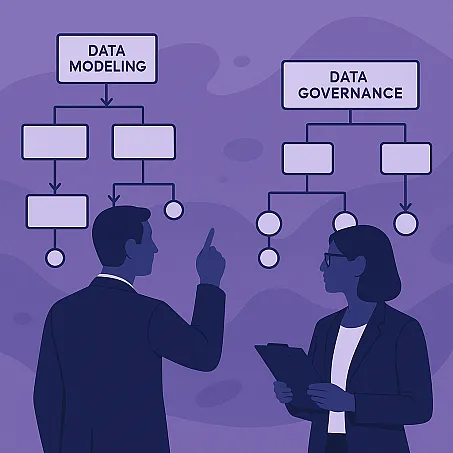Introduction
If you’ve ever been part of a data project, you’ve likely seen this scenario:
The technical team is sketching complex diagrams, mapping out databases and relationships.
Meanwhile, the governance team is knee-deep in policies, ownership charts, and compliance requirements.
It can feel like two entirely separate worlds - but in reality, without each other, both will fail.
In the context of IFS Cloud implementations, the interplay between data modeling and data governance is not just important - it’s essential for long-term success.
What is Data Modeling?
Think of data modeling as the blueprint of your ERP data architecture.
In IFS Cloud, this means defining:
-
Data entities (e.g., Customers, Orders, Products)
-
Attributes within each entity (e.g., Customer Name, Order Date, Product Price)
-
Relationships between entities (e.g., One customer can place many orders)
Without a clear blueprint, every module or business unit risks building its own version of the “data house,” leading to duplicated records, mismatched definitions, and reporting chaos.
And Data Governance?
Data governance is the rulebook for managing and maintaining that blueprint over time.
In an IFS Cloud environment, it determines:
-
Who can access which data (permission sets, role-based access control)
-
What data standards must be followed (naming conventions, master data rules)
-
How data is kept clean and compliant (validation rules, periodic audits)
Without governance, even the most elegant ERP data model will degrade - duplicate customers creep in, old product codes linger, and regulatory compliance is put at risk.
Where the Magic Happens - Integration
The real value comes when data modeling and data governance operate in a continuous loop:
-
Governance guides modeling: Ensuring IFS Cloud configuration follows agreed definitions, compliance requirements, and quality standards.
-
Modeling enables governance: Providing the structure for tracking data lineage, monitoring quality, and enforcing policy.
It’s not a one-time project phase - it’s an iterative cycle:
Governance → Modeling → Governance → repeat.
Why This Matters for IFS Cloud Projects
When modeling and governance are aligned from the start:
-
A common “data language” emerges across modules and teams.
-
Compliance is built in - no scrambling before audits.
-
Data quality issues are easier to detect and resolve.
-
Decision-making accelerates because reports are based on trusted data.
In short, your ERP stops being a repository of inconsistent records and becomes a reliable business asset.
A Practical Takeaway for Your Business
If your data governance efforts feel stuck, look at your ERP data models.
If your data models are out of date, review your governance processes.
The truth is simple: You can’t fix one without the other.
In IFS Cloud projects, treating data modeling and governance as independent silos is a recipe for long-term inefficiency.
Final Thought
Data modeling and data governance are the unsung power couple of IFS Cloud implementations.
When they work together, your ERP becomes more than just a system - it becomes a trusted foundation for business growth.
